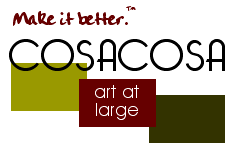



Many contemporary artists have searched for ways to recover this archaic relationship of art, healing and ritual. Leaving the studio, they have engaged with other people to create new forms of art, that may open possibilities for healing on different levels: individually, among people, and even for wounded landscapes. Christiane Corbat is an artist who works with individuals dealing with illness and other traumas, creating plaster body casts and adorning them with symbolically healing materials and images. Duane McDiarmid has created a ritual artwork around an oil spill, showing concern for our connection to “sick” environments. Working with a whole community in Chengdu, China, artist Betsy Damon oversaw ritual events that exposed a river's pollution; later she was invited to return and help plan a riverside water garden for that city.
Pedro Ospina, the artist of COSACOSA's Safe Harbor project, is deeply comfortable with folk traditions of Mexico, Brazil and other countries that have roots in shamanic curative practices. His commitment to work with traditional artisans, with people of indigenous heritage, and with marginalized groups has given him a full-bodied sense of how art can work outside the mainstream system of exhibition and sales.
Art organizations working within disenfranchised and disabled communities have also developed innovative ways to rejoin art and healing. COSACOSA's decision to create an artwork around milagros -- small holy offerings that may be fashioned in the form of the body part to be healed or other symbolic imagery -- was an inspired one. By asking the children (some of them dealing with serious illness) and older people to think of a wish or hope for their future, or an offering they would like to make, the Safe Harbor project opened the possibility for their own art-making to carry conscious healing intent. The resulting several hundred pieces are rich with mythological resonance: fish, butterflies, many birds, a boat, and other images of hope and transformation. Even pieces spelling the maker's name, or depicting money or a house, are empowering, reinforcing feelings of safety, security or identity.
The large artwork encompassing this collective effort, which will lend its wishes and hopes to the well-travelled lobby of Temple University Children's Medical Center, speaks of something more than individuals focusing on their own healing. Along with the many art-making workshops, in which neighborhood children worked alongside hospitalized children, and older people alongside younger people, the piece itself points to community-wide possibilities for healing. The original ground of healing art was shared ritual; in works like this, we can begin to see how, by gathering together a whole (healed) group of individuals, such processes may restore -- and empower -- stressed or fragmented communities.
Miriam Seidel contributes to Art in America (as Corresponding Editor), the Philadelphia Inquirer and other publications. She has written before on the connections among art, ritual and healing.